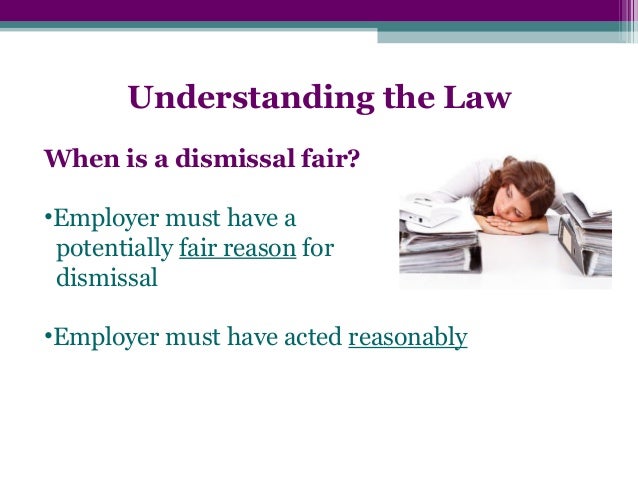Acas Capability Dismissal
Fairness and reasonableness
An employer must act reasonably in all the circumstances in treating the reason for dismissing the employee as a sufficient reason for the dismissal. In other words, not only must the employer have a valid reason for the dismissal, but also he must have acted reasonably in all the circumstances entailed in dismissing the employee for that particular reason. The question whether the employer acted reasonably not only involves consideration of the way in which the dismissal was carried out, but also whether he acted reasonably in relation to the situation leading up to the decision to dismiss the employee. For example, if the employee was dismissed for misconduct or lack of capability, it is necessary to consider whether he was warned and given a chance to improve or, if redundancy was the reason for dismissal, whether the employee was considered for alternative work within the same organisation.
The sorts of questions that will be considered should the matter come before a tribunal are listed below.
Case studies - Capability dismissal It can be necessary for a business to performance manage its employees. However, it doesn’t necessarily mean they can simply jump in and dismiss someone without first giving them a reasonable opportunity to improve. Additionally, if a capability issue is linked to an employee’s health, the employer must try to help them do their job better before ordering their dismissal. Disciplinary Procedures. According to employment law and the ACAS Code of Practices, different disciplinary procedures are relevant for different circumstances. Capability or performance is about an employee's ability to do the job. Some employers might have a separate procedure for dealing with capability or performance issues that should be based on: support; training; encouragement to improve; Whether the employer deals with the issue under a capability or disciplinary procedure, they must do so fairly. Letter templates from Acas for giving an employee the outcome of a disciplinary after a decision has been made. Free to download and use. A letter to an employee giving the disciplinary outcome of dismissal, other serious action or no action. OpenDocument Text (ODT) format.
- Was the employee given a fair hearing by the employer?
- What evidence was used at the hearing and was it all used?
- Did the employee have a representative at the hearing or a trade union official?
- If there was more than one employee involved, were they all treated in the same way?
- Had the employee done this before?
- Did the employer consider warnings? Were these used in the past?
- Did the employer consider the overall performance of the employee? For example, did the employee previously have a long record of good work and behaviour?
- Could the employer have disciplined the employee instead of dismissing him?
- Did the employee have an effective right of appeal against the decision?
- Was the whole procedure carried out in the same way as previous procedures, if not how did it differ and why?
- Was the conduct of the employee looked into thoroughly?
- Did the employer believe that the employee committed the offence?
ACAS
The ACAS Code of Practice 1 is the benchmark of best practice and gives employers practical advice on how to deal with disciplinary matters in a way which is fair and can be seen to be fair by their employees.
The ACAS Code is a statutory code and tribunals will take into account any provision of the code which appears to them to be relevant to any question before them and will consider whether or not an employer has followed it. It should be read in conjunction with the Guidance, which is non-statutory.
There’s no straightforward way to let go of an employee due to ill health. There are five fair reasons to dismiss an employee, they are:
- Misconduct.
- Redundancy.
- Illegality.
- Capability.
- And other substantial reasons.
Dismissing staff due to sickness is dependent on their capability. This requires you to prove that you’ve dismissed them because of their inability to perform tasks, as opposed to discriminating against them. You’ll also have to show that you’ve given them fair opportunities to improve.
It’s important to have a procedure in place to avoid claims of discrimination or unfair dismissal.
This post explores the process for termination of employment due to ill health.
Acas Capability Dismissal Vs
How to fairly dismiss an employee on grounds of ill health?
Dismissal should be a last resort after exhausting other efforts. Remember to consider reasonable adjustments such as flexible working hours, remote working or issuing alternative responsibilities.
If you aren’t able to make reasonable adjustments, then it may be fair to dismiss them by reason or incapability.
To avoid claims of discrimination, you’ll have to prove that dismissal was fair and as a result of their incapability.
This includes evidence of reasonable adjustments made as well as any other opportunities provided to improve said employee’s performance or to return them to work.
Before dismissal on grounds of capability due to ill health, you’ll need to find out the current medical positions. Consider contacting the employee’s GP (with the employee’s permission, of course), for a report on their illness and their recommendations in relation to working.
Remember to request ‘fit notes’ after prolonged absences. These are a great way to prepare employees for returning to work. It gives you the opportunity to gain insight into what the doctor thinks could get the employee back to work.
Some factors to consider before dismissal include the:
- Nature of illness.
- Likelihood of reoccurring absences due to ill health.
- Length of absence.
- Length of service.
- Impact on business.
- Impact on other employees.
- Organisation’s sickness policy.
You can also consider hiring an occupational health specialist to carry out a health assessment. Conducting this assessment allows you to confirm what the problem is, how it’ll affect their job and when/if they’ll be ready to return to work.
Dismissal during the probationary period due to sickness
While dismissal during the probationary period due to sickness is not uncommon, it’s important to take extra precaution to avoid claims of discrimination.
It’s understandably frustrating to hire an employee on a three to six-month probation period only for them to take some weeks off due to illness.

Acas Capability Dismissal Meaning
Instead of dismissing a new recruit due to a disability, you may consider reasonable adjustments like extending their probation period to give them more time. Remember to inform the employee about this extension and your right to do so.
Remember that you have a legal duty to support disability in the workplace. Before you consider dismissing an employee, you need to prove that you’ve exhausted all other avenues of trying to support them.
Dismissal due to ill health: Benefits
Apart from Statutory Sick Pay (SSP) when capability dismissal is due to ill health, other benefits include:

- Employment and Support Allowance (ESA).
- Personal Independence Payment (PIP).
- Universal Credit.
Most employee benefits including ESA are now covered under Universal Credit. However, there’s also a ‘new style ESA’ that employees unable to work or with reduced hours may be eligible to depending on their National Insurance record.
Expert support
Contact us today for advice on absence and sickness policies that works for your organisation. Speak to a Croner expert on 0808 145 3375.
Disclaimer: These guides are for guidance only and should not be treated as a substitute for specific legal advice on your situation.